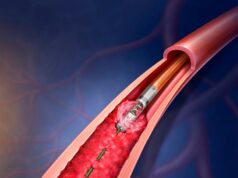
Over the past few years, we have seen an increased awareness of the role of mental health in several health outcomes, note Marlene Grenon and Greg J Zahner. One may wonder what is happening with our patients who suffer from vascular diseases; are they similarly affected by mental health diseases? While the rising toll of peripheral artery disease (PAD) on our world’s ageing population is no secret to the vascular surgeon, depression has quietly become the second leading cause of years lived with disability.1
In the USA alone, 20.8% of Americans will be afflicted by mood disorders during their lifetimes,2 with increasing rates among teenagers and young adults.3 While it would not be unreasonable to doubt whether PAD and depression—two seemingly unrelated disorders—had any appreciable link, the evidence thus far begs for reconsideration.
In coronary artery disease, depression has been recognised as a strong risk factor, as highlighted by the INTERHEART case-control study of approximately 30,000 participants, which showed that psychosocial factors (depression, locus of control, perceived stress, and life events) were associated with an adjusted odds ratio of 2.67 for myocardial infarction. This effect was stronger than many traditional risk factors such as diabetes, smoking, hypertension, and obesity.4
The 2010 Global Burden of Disease Study was one of the first studies to officially recognise depression as a coronary heart disease risk factor.5 Additionally, among patients who have heart disease, those who develop post-myocardial infarction depression are at double the odds of death.6,7 In the Heart and Soul Study, a prospective cohort of 1,024 veterans which aimed to understand the link between mental health and vascular disease, the authors examined the relationship between depression and PAD; they found an astonishing hazard ratio of 2.09 for developing PAD when adjusting for age and sex.8 Furthermore, depression was the strongest risk factor for PAD among the women in the cohort.9 But how does depression lead to PAD?
Fowkes and colleagues have suggested that industrialisation, urbanisation, and accelerating changes in technology lead to an elevated risk of PAD through increased stress and depression in addition to worse diet and lack of exercise.10 Depression is also associated with smoking, physical inactivity, and medication non-adherence.8 Emerging evidence further supports a more direct physiological link, including lower heart rate variability, enhanced activity of the hypothalamic-pituitary-adrenal axis, increased catecholamines, platelet activation, and increased inflammation.11 Similarly, higher levels of stress, which may be a precursor to depression, are associated with worse endothelial function.12 Even more compelling is the growing amount of data on the significant association between co-morbid depression and worse clinical outcomes in PAD patients. Patients with co-morbid depression have reduced walking distance, even when adjusting for the ankle-brachial index,13 as well as poorer quality of life.14 After vascular intervention, they will have less functional improvement and higher rates of restenosis, worse symptoms, and greater risk of subsequent cardiovascular events, death, and PAD in the contralateral limb.15,16
Psychotherapy and pharmacotherapy are the mainstays of depression treatment, but not enough research has been conducted to determine whether these treatments mitigate vascular risk. Due to the safety of depression treatment and its efficacy in treating depression symptoms, the American Heart Association (AHA) currently recommends selective serotonin reuptake inhibitors (SSRIs), cognitive therapy, and exercise for depressed patients with coronary artery disease.
No current guidelines exist for depression in PAD. While more research is needed before official guidelines are issued, the current evidence is certainly enough to warrant action. We believe there are tangible steps each vascular surgeon can and should take in their daily practice to mitigate the negative impact of co-morbid depression on PAD and improve the overall wellbeing of their patients.
You cannot treat a problem you cannot see
Whether or not asking about your patient’s emotional wellbeing or personal life is part of your clinical style, the importance of screening for depression is paramount and certainly relevant for improving clinical outcomes. The AHA recommends screening patients with heart disease for depression using the PHQ-2, which consists of two simple questions. Over the past two weeks, how often have you been bothered by any of the following problems? Little interest or pleasure in doing things. Feeling down, depressed or hopeless. If they answer affirmatively to either question, then have them complete a PHQ-9 for more comprehensive screening.17 The PHQ-9 is 88% sensitive and 88% specific for major depression, and a score of 10 is used as the cut-off for moderate depression.18
Once you have identified possible depression, do not let it go unaddressed
Just like a non-healing ulcer, depression can linger and cause problems for your patients now and down the road. Follow-up with them to make sure treatment is being pursued.
Know your limits and refer when necessary
Concerned about a potentially depressed patient not seeking treatment? Act and refer them to appropriate psychological, psychiatric, behavioural health, or wellness programmes. If you practise in an integrated health system, follow-up with their other providers and communicate your concerns with the patient’s primary care provider.
Motivated to do more? Think innovatively!
As evidence on the importance of vascular rehabilitation for PAD patients mounts, we must consider all aspects of a patient’s wellness. In the last year, we have partnered with the new University of California San Francisco (UCSF) Bridge’s Curriculum to launch a vascular rehab programme at the San Francisco VA Medical Center. Under supervision, medical students serve as health coaches during this 12-week programme aimed at secondary prevention. The programme is based on five pillars: exercise, diet/nutrition, smoking cessation, medication adherence, and stress management/mindfulness. In summary, data are accumulating supporting a close relationship between depression and PAD. Furthermore, depression should potentially be considered a risk factor for PAD, and the impact it has on patients’ outcomes should be recognised. It is time to engage in this conversation with our patients and amongst ourselves in order to develop optimal treatment strategies and hopefully improve outcomes.
Marlene Grenon is Associate Professor of the Division of Vascular and Endovascular Surgery at UCSF, and Greg J Zahner is a medical student at UCSF San Francisco, USA
References
1 Ferrari et al, PLOS Medicine 2012; 10(11):e1001547.
2 Kessler et al, JAMA Psychiatry 2005; 62(6):593–602.
3 Mojtabai et al, Pediatrics 2016; 138(6):e20161878.
4 Yusuf et al, Lancet 2004; 364:937–952.
5 Charlson et al, BMC Medicine 2011; 9:47.
6 van Melle et al, Psychosomatic Medicine 2004; 66(6):814–822.
7 Barth et al, Psychosomatic Medicine 2004; 66:802–813.
8 Grenon et al, Journal of the American Heart Association 2012; 1:e002667.
9 Grenon et al, Journal of Vascular Surgery 2014; 60(2):396–403.
10 Fowkes et al, Nature Reviews Cardiology 2017; 14:156–170.
11 Elderon et al, Progress in Cardiovascular Diseases 2013; 55:511–523.
12 Grenon et al, Journal of the American Heart Association 2016; 5:e003010.
13 Smolderen et al, Journal of Affective Disorders 2008; 110:27–35.
14 Smolderen et al, Vascular Medicine 2011; 16(4):260–266.
15 Cherr et al, Journal of Vascular Surgery 2007; 45(4):744–750.
16 Cherr et al, Journal of General Internal Medicine 2008; 23(5):629–634.
17 Lichtman et al, Circulation 2008; 118:0–0.
18 Kroenke et al, Journal of General Internal Medicine 2001; 16:606–613.














Hi there, the whole thing is going nicely here and ofcourse
every one is sharing data, that’s actually good, keep up writing.